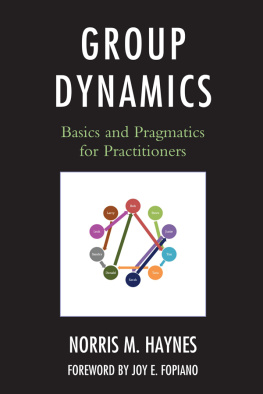Group Dynamics
Basics and Pragmatics for Practitioners
Norris M. Haynes
Foreword by Joy E. Fopiano
University Press of America, Inc.
Lanham Boulder New York Toronto Plymouth, UK
Copyright 2012 by
University Press of America, Inc.
4501 Forbes Boulevard
Suite 200
Lanham, Maryland 20706
UPA Acquisitions Department (301) 459-3366
Estover Road
Plymouth PL6 7PY
United Kingdom
All rights reserved
Printed in the United States of America
British Library Cataloging in Publication Information Available
Library of Congress Control Number: 2011936044
ISBN: 978-0-7618-5697-9 (paperback : alk. paper)
eISBN: 978-0-7618-5698-6
 The paper used in this publication meets the minimum requirements of American National Standard for Information SciencesPermanence of Paper for Printed Library Materials, ANSI Z39.48-1992
The paper used in this publication meets the minimum requirements of American National Standard for Information SciencesPermanence of Paper for Printed Library Materials, ANSI Z39.48-1992
Foreword
Most of us daily, from the very young to our population of retired and elder persons, participate in a wide variety of group experiences. We gather in groups for play, for work, for fellowship, to learn, and to glean support. We form groups when we are very happy and we form groups as we grieve our pain. We may be organized in groups to provide information, to build community, or to contribute hope. We are social creatures who use language and the sharing of ourselves to move forward with our interests and with our goals. With that, an understanding of how groups work; how they operate; how they can empower may be essential to the graduate student experience. As a graduate school trainer of counselors and psychologists, I believe that a study and understanding of groups and their membership is critical.
Dr. Haynes has prepared a valuable guide for counselors and school psychologists to begin to expand their foundational understanding of groups. It is clear that this narrative could be used as a vital companion to a group course presented as a graduate school learning experience. The book takes the reader beyond an abstract and more theoretical understanding of group dynamics and the specific stages of groups to highly detailed examples of how graduate students learning develops through this teaching model. Journal reflections prepared by graduate students who were class participants illustrate the power of their individual learning through the conceptual model Dr. Haynes portrays. The reader sees how impactful the exercises and the experience of being a group member concurrently to taking a group dynamics course in this format has been to student participants. Indeed, the accounts presented I found to be stirring.
Graduate students express their surprise at how rapidly the group process moved forward as they join class. Students are able to tie the conceptual model of group development to what they are actually experiencing as a group member. Touched by the disclosures of peer colleagues, relationships have been formed and continued as a result of these specific group experiences. As reader, one can see the sustaining impact these concepts have on students and how useful groups can be when successfully organized and operated in schools and in community.
For over fifteen years Dr. Haynes has been excited to teach classes in group dynamics to graduate students in school counseling, clinical mental health and school psychology. Public school districts and community agencies run groups for children frequently and perhaps not always with clarity of purpose and proper evaluation. In this text, Dr. Haynes supports the new practitioner in learning how to appropriately establish a new group, determine a structure for selecting members, establish how to set goals, and how to gather data to evaluate progress. Groups are designed with purpose, and evaluation is a critical and fundamental component of assessing progress. Further, with great respect to both reader and participant, Dr. Haynes shares how significant sensitive group leadership is to facilitate discovery and growth for individual group members.
Graduate students may recognize some of the activities presented here to illustrate learning goals. However, what becomes clear is how the structure of these experiences weaves to shape a curriculum designed to enhance the training necessary for future counselors and psychologists to become themselves skilled group facilitators. As a trainer of school psychologists, I am pleased to see clear emphasis on data gathering. This, with group analysis, and the evaluation component will allow the field professional to use groups to enhance their understanding of problems and how to create solutions.
We advocate best practice for our field professionals. Superior group experiences may be one vehicle to encourage children who participate to feel safe to express themselves and stretch to reach new goals. Children and youth, now perhaps more than ever, may benefit from joining together to learn that they are not alone in their experience. In these times of worldwide stress, supporting children to be valued contributing members of a group may have especially far reaching impact for their academic learning and personal emotional development.
Professor Haynes has written this book as a practical guide to the understanding, teaching and facilitating of group dynamics in various settings. He does not purport to provide profound analyses or delve deeply into group theory although he does provide an overview of selected theories. The essence and value in this work lie in the understandable and engaging manner in which group dynamics concepts come alive and the multiple audiences to which this work would appeal.
Dr. Joy E. Fopiano
Chapter One
Defining Groups, Types of Groups and Value of Groups
Each individual is in some way influenced by at least one group and most likely by multiple groups simultaneously. For example, a person may be influenced by family members and by close friends at the same time. However, individuals seldom reflect on the multiple and significant influences of groups on their lives. Some groups have lasting impact on individuals, help to shape their personalities and help to chart the course of their lives. Yet groups are not often given the attention nor assigned the importance in the personal lives of individuals that they deserve. In this introductory chapter, an effort is made to establish an understanding of what constitutes a group, explain the composition and purpose of different types of groups, and discuss the value that groups have in the lives of individuals.
Defining Groups
A group may be defined as, an entity comprised of individuals who come together for a common purpose and whose behaviors in the group are guided by a set of shared values and norms, (Haynes, 1998). The elements of this definition that separate a group from a crowd or just an assembly of people are: a common purpose shared values and shared norms.
Common purpose means that the members of the group are participating in the group activities to achieve similar goals. They are motivated to participate in the group process and dynamics by a shared set of desired outcomes.
Shared values means that the members of the group share certain core beliefs about what the structure and essence of the group is and strive to maintain the groups integrity.
Shared norms means that the members of the group agree on certain overarching principles that direct or influence the manner in which the group members behave and interact with one another in the context of the group. In childrens groups these are referred to as rules.
A group is different from the collective personalities of the individuals who form the group. It is a unique, dynamic whole that grows out of the interactions among group members in context. The group that is formed has its own identity that is different from the collection of individual identities of the group members. It is acknowledged however, that each individual brings an identity that includes his or her personal history, values, needs and desires to the group. During the group process the individual identity contributes to the dynamics of the group and is influenced by the group process. Sometimes the individual adheres so strongly to his/her identity while in the group that he or she remains an outsider to the group.







 The paper used in this publication meets the minimum requirements of American National Standard for Information SciencesPermanence of Paper for Printed Library Materials, ANSI Z39.48-1992
The paper used in this publication meets the minimum requirements of American National Standard for Information SciencesPermanence of Paper for Printed Library Materials, ANSI Z39.48-1992